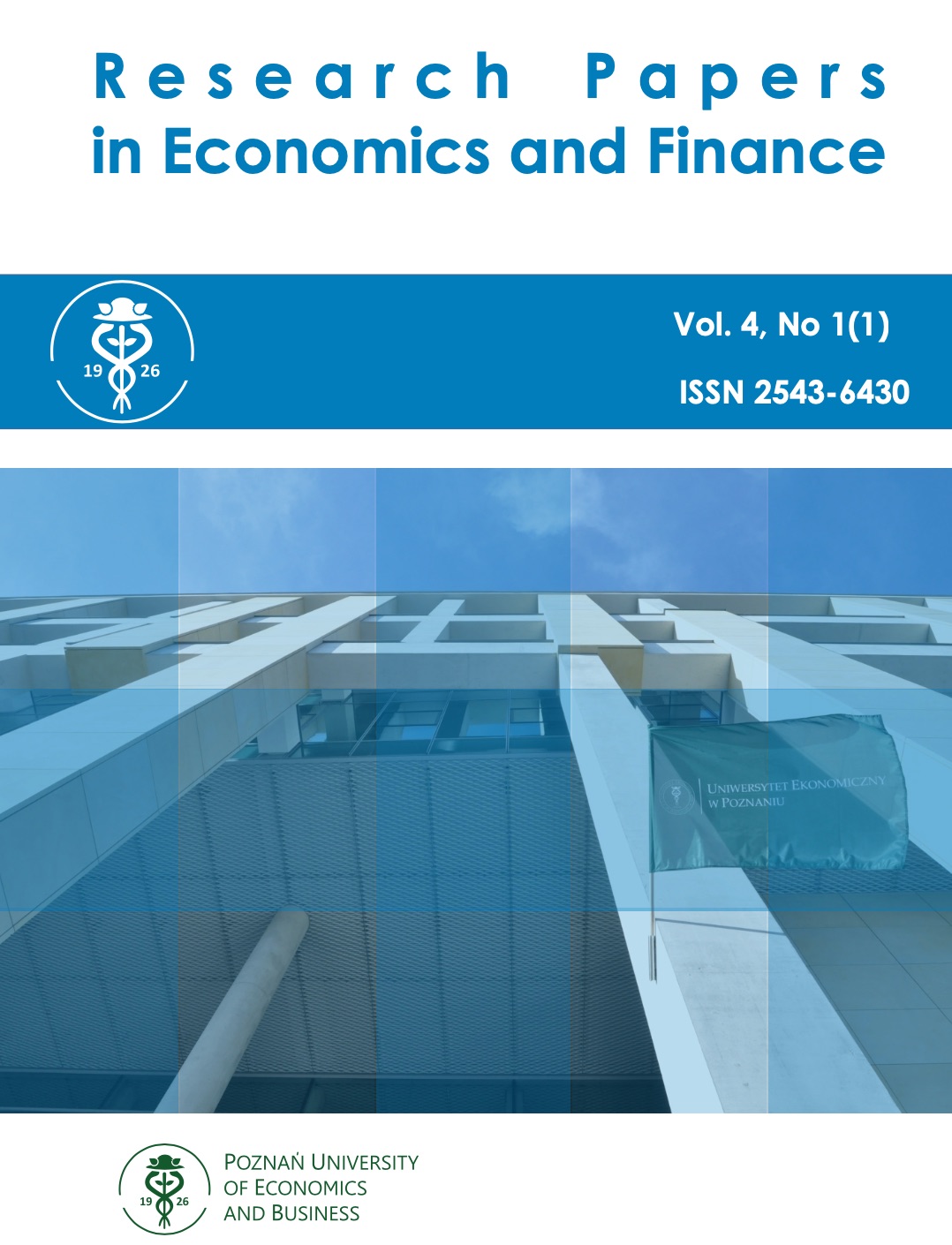Bayesian combined forecasts and Monte Carlo simulations to improve inflation rate predictions in Romania
DOI:
https://doi.org/10.18559/ref.2020.1.1Keywords:
forecasts accuracy, Bayesian forecasts combination, shrinkage parameter, econometric modelAbstract
In this paper we applied the regression approach and Bayesian inference to obtain more accurate forecasts of the inflation rate in the case of the Romanian economy. The necessity of using the most accurate forecasts for the inflation rate is required by the realisation of economic criteria for the accession to the eurozone and by the inflation targeting strategy of the National Bank of Romania. Considering the assumption that simple econometric models provide better forecasts than complex models, in this paper we combined various forecasts from individual models using as prior information the expectations of experts. The empirical findings for Romanian inflation rate forecasts over the horizon of 2016-2018 indicated that a fixed effects model performed better than other simple models (autoregressive moving average model, dynamic model, simple and multiple linear model, VAR, Bayesian VAR, simultaneous equations model). The Bayesian combined forecasts that used experts’ predictions as priors, with a shrinkage parameter tending to infinity, improved the accuracy of all predictions using individual models, outperforming also naïve forecasts and zero and equal weights forecasts. However, predictions based on Monte Carlo simulation outperformed all the scenarios in terms of the mean error and mean absolute error.
Downloads
References
Armstrong, J. S. (2005). The Forecasting Canon: Nine Generalizations to Improve Forecast Accuracy. International Journal of Applied Forecasting, 1, 29-35. Available at SSRN: https://ssrn.com/abstract=868496
View in Google Scholar
Atkeson, A., & Ohanian, L. E. (2001). Are Phillips curves useful for forecasting inflation? Federal Reserve Bank of Minneapolis. Quarterly Review-Federal Reserve Bank of Minneapolis, 25(1), 2-11.
View in Google Scholar
Baciu, I. C. (2015). Stochastic Models for Forecasting Inflation Rate. Empirical Evidence from Romania. Procedia Economics and Finance, 20, 44-52.
View in Google Scholar
Budina, N., Maliszewski, W., De Menil, G., &Turlea, G. (2006). Money, inflation and output in Romania, 1992–2000. Journal of International Money and Finance, 25(2), 330-347.
View in Google Scholar
Coulson, N., Robins, R. (1993). Forecast combination in a dynamic setting, Journal of Forecasting, 12, 63-67.
View in Google Scholar
Diebold, F.X., Pauly, P. (1990). The use of prior information in forecast combination. International Journal of Forecasting, 6, 503-508.
View in Google Scholar
Dobrescu, E. (2009). Measuring the Interaction of Structural Changes with Inflation. Journal for Economic Forecasting, 6(5), 5-99.
View in Google Scholar
Dobrescu, E. (2017). Modelling an Emergent Economy and Parameter Instability Problem. Journal for Economic Forecasting, 20(2), 5-28.
View in Google Scholar
Dritsakis, N. (2004). A causal relationship between inflation and productivity: An empirical approach for Romania. American Journal of Applied Sciences, 1(2), 121-128.
View in Google Scholar
Furtula, S., Durkalić, D., & Simionescu, M. (2018). Testing Phillips Curve for Serbian and Romanian Economy. Romanian Statistical Review, 3(2018), 40-51.
View in Google Scholar
Geweke, J., Whiteman, C. (2006). Bayesian forecasting, Handbook of economic forecasting, 3-80.
View in Google Scholar
Gomez, M.I., Gonzalez, E.R., Melo, L.F. (2012). Forecasting food inflation in developing countries with inflation regimes. American Journal Of Agricultural Economics, 94, 153-173.
View in Google Scholar
Gordon, R. J. (1990). The Phillips curve now and then (No. w3393). National Bureau of Economic Research.
View in Google Scholar
Gordon, R. J., & Stock, J. H. (1998). Foundations of the Goldilocks economy: supply shocks and the time-varying NAIRU. Brookings papers on economic activity, 1998(2), 297-346.
View in Google Scholar
Granger, C.W.J., Ramanathan, R. (1984). Improved methods of combining forecasts. Journal of Forecasting, 3, 179–204.
View in Google Scholar
Julio, J.M., Bratu Simionescu, M. (2013). The evaluation of forecasts uncertainty for rate of inflation using a fan chart. Journal of Economic Computation and Economic Cybernetics and Research, 2, 115-128.
View in Google Scholar
Koop, G., Korobilis, D. (2010).Bayesian Multivariate Time Series Methods for Empirical Macroeconomics, http://personal.strath.ac.uk/gary.koop/kk3.pdf.
View in Google Scholar
Koop, G., Potter, S. (2003). Forecasting in large macroeconomic panels using Bayesian model averaging. Staff report 163, Federal Reserve Bank of New York.
View in Google Scholar
Liao, Y. (2014), Inflation Forecast Literature Review 1969-2013, SSRN 2444121, available online at: http://papers.ssrn.com/sol3/papers.cfm?abstract_id=2444121.
View in Google Scholar
Mihai, N. D., Cristina, S. M., Lucian, B., Lucia, C., & Gabriel, I. (2016). Inflation in Romania and its evolution in view of accession to the eurozone. Journal of Information Systems & Operations Management, 1.
View in Google Scholar
Poncela, P., Rodríguez, J., Sánchez-Mangas, R., &Senra, E. (2011). Forecast combination through dimension reduction techniques. International Journal of Forecasting, 27(2), 224-237.
View in Google Scholar
Simionescu, M. (2014). The Performance of Predictions Based on the Dobrescu Macromodel for the Romanian Economy. Journal for Economic Forecasting, (3), 179-195.
View in Google Scholar
Sovbetov, Y., & Kaplan, M. (2019). Empirical examination of the stability of expectations-Augmented Phillips Curve for developing and developed countries. Theoretical & Applied Economics, 2(2), 63-78.
View in Google Scholar
Stock, J. H., & Watson, M. W. (2007). Why has US inflation become harder to forecast? Journal of Money, Credit and Banking, 39(s1), 3-33.
View in Google Scholar
Terceno, A., Vigier, H. (2011). Economic – Financial Forecasting Model of Business Using Fuzzy Relations. Journal of Economic Computation and Economic Cybernetics and Research, 1, 215-233.
View in Google Scholar
Tian, J & Zhou, Q 2013, Predictability of technical analysis: a combination approach, The 33th International Symposium on Forecasting 2013, Seoul, Coreea, 23-26 June 2013, http://forecasters.org/isf/submissions/proceedings/
View in Google Scholar
Timmermann, A. (2006). Forecast combination. Handbook of economic forecasting, 135-196.
View in Google Scholar
Velandia, L. F. M., Maya, R. A. L., & Villamizar-Villegas, M. (2014). Bayesian Combination for Inflation Forecasts: The Effects of a Prior Based on Central Banks’ Estimates (No. 012323). BANCO DE LA REPÚBLICA.
View in Google Scholar
Wright, J.H. (2008). Bayesian model averaging and exchange rate forecasts. Journal of Econometrics, 146, 329-341.
View in Google Scholar
Zellner, A. (1986). On assessing prior distributions and Bayesian regression analysis with g-prior distributions. Journal of Econometrics, 40, 183-202.
View in Google Scholar

 Editorial Office: Research Papers in Economics and Finance
Editorial Office: Research Papers in Economics and Finance 